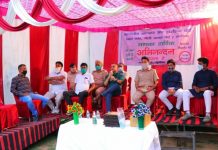
Mohali
21 August 2022
DIVYA AZAD
With dengue cases on a steady rise in the city, coordinated measures need to be undertaken to target mosquito breeding sites, besides use of mosquito repellants and wearing appropriate clothing needs to be encouraged.
Dr Parvinder Chawla, Senior Consultant, Internal Medicine, Fortis Hospital Mohali, through an advisory gives an insight on the causes, symptoms and ways to prevent the disease.
Discussing the issue, Dr Chawla, said, “As dengue cases continue to surface, panic has gripped people yet again. Dengue outbreak seems to have now become an annual phenomenon. It is time to revise the lessons learnt from the earlier outbreaks to avoid history from repeating itself. A proactive approach towards getting rid of mosquito breeding sites in and around our houses needs to be adopted to keep the disease at bay. In addition, improved awareness regarding the symptoms, the monitoring and the basic management will go a long way in helping us tide over the situation better.”
Explaining the cause of dengue, Dr Chawla, said, “Dengue is caused by four types of Dengue viruses that spread by infected mosquitoes. Cases of dengue usually rise in the monsoon season. Patients with dengue fever exhibit symptoms such as chills, fatigue, fever, loss of appetite, nausea, vomiting, body rash, aches and pains (eye pain, typically behind the eyes, muscle, joint, or bone pain).
Just like COVID, Dengue infection too may be subclinical – infected but not developing any symptoms. For most infected patients, Dengue infection behaves like just another viral infection with fever and body aches improving within a few days without the need for any aggressive medical treatment apart from the fever lowering medicines and rest. A typical patient with dengue goes through three phases: Febrile phase, critical phase and recovery phase. In the initial febrile phase, fever and body pain are the hallmark symptoms and fever-reducing medicines (paracetamol) and plenty of fluids are all that is required. Most patients seem to go straight into the recovery phase from the febrile phase without developing an overt critical phase. Some patients however develop symptoms which are medically called ‘warning signs’ which indicate the need for hospitalization and close monitoring. The warning signs include vomiting, pain in the abdomen, severe headache, persisting pain anywhere else in the body, bleeding from any site and inability to continue with good liquid intake. Presence of any of these warning signs means that the patient is definitely in the critical phase and needs to be monitored closely for at least 48-72 hours in a hospital setting.”
Talking about monitoring the blood platelet count in patients with Dengue, Dr Chawla said, “Monitoring hemoglobin and hematocrit is more important than even monitoring platelet count in Dengue. We should be checking these two values on the 2nd / 3rd day of fever and monitor them closely especially in a patient who continues to have symptoms. An increase in hemoglobin and hematocrit signifies poor oral intake (and hence the need for hospitalization), while a falling hemoglobin and hematocrit along with clinical deterioration suggests internal bleeding and hence, requires hospitalization too. A slight decrease in these two parameters along with improvement in symptoms is indicative of the patient entering the recovery phase of the disease. Falling platelet count alone (unless it is drastically low) usually doesn’t imply the need for admission to a hospital. Even if the platelet count is low, platelets need to be transfused only if the count is below ~ 10,000/cmm or there is evidence of active bleeding from any site. For most other patients in the critical phase of the disease, judicious guarded intravenous fluids suffice to tide over the crisis.”
She emphasized the Four Ps of Prevention, ‘Paracetamol’, Plenty of fluids and Proactive medical consultation in case of persisting symptoms as an antidote to panic caused by the impending outbreak.















































